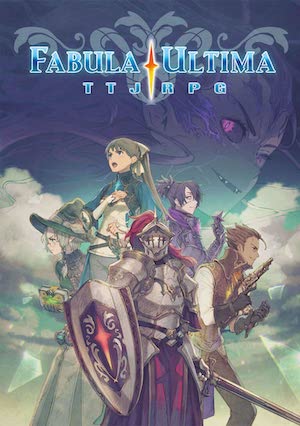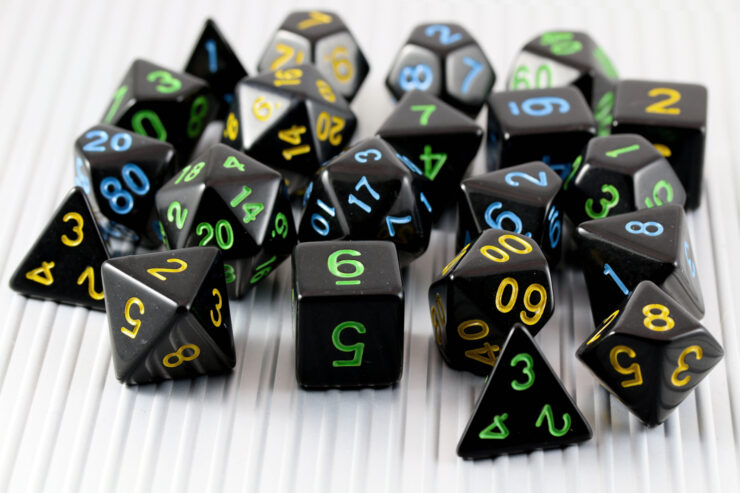I suspect the vast majority of tabletop roleplaying games are labors of love. A few blockbusters aside, there’s just not a lot of money to be made in the field. Logic suggests that creators have to be motivated by something other than monetary returns1. Still, every once in a while, one encounters a game whose designers and game company have gone well beyond what even enthusiasm might be expected to inspire.
Perhaps some examples are in order.
Larry Niven’s Ringworld: Roleplaying Adventure Beneath the Great Arch by John Hewitt and Sherman Kahn (1984)

Publisher Chaosium was no stranger to tie-in roleplaying games, having adapted properties from Elric to Elfquest2. Their Call of Cthulhu is one of the great success stories of the industry. However, their Ringworld game is a particular standout, at least for me.
The box was deceptively light. Inside were four saddle-stitched books, into which were crammed a stupendous amount of information. Not only did Hewitt, Kahn, et al. opt for a microdot-sized font, they managed to provide more pages of material than there were technically pages on which to provide it. Additionally, the game had production values almost unheard of at the time. Lisa A. Free’s art was only one of the attractions. Although some material had to be deferred to the Ringworld Companion, the box contained material sufficient to run a Known Space game, not merely the Ringworld-focused campaign the title suggests.
Alas, Chaosium only had time to produce the main game and the companion before they lost the rights. Ringworld is out of print and surviving copies are not cheap. Happily, readers may comfort themselves with the knowledge that I know where my copy is…
Star Wars: The Roleplaying Game by Greg Costikyan (1987)

Gosh, you say, perhaps a tie-in product for a movie whose prodigious sales arguably reshaped the film industry might have just the tiniest smidgen of profit motive. I freely grant that, but consider: in 1987, the most recent Star Wars movie was four years old and there was no prospect of a fourth movie on the horizon. Getting the rights to make this game was a big win for publisher West End Games, but not quite the mega-hit that modern readers might expect from the title.
The core rulebook was a perfectly functional set of rules pitting virtuous Resistance against the Empire. Where Star Wars stood out was the prodigious quantity of authoritative material produced while WEG had the rights. Again, some readers might point out that profit might explain that as well, in that it’s hard to sell product that does not exist. However, WEG’s Star Wars source books were of sufficient quality that they provided the foundation of the late, lamented Star Wars Expanded Universe.
Dragonbane: Mirth and Mayhem Roleplaying by Tomas Härenstam (2023)

Dragonbane is the English language version of the most recent edition of the venerable Swedish tabletop fantasy roleplaying game, Drakar och Demoner (DoD). Originally a translation of Chaosium’s Basic Roleplaying (BRP) and the Magic World setting from Worlds of Wonder, Drakar och Demoner evolved considerably over the decades, despite which it is possible to see the BRP bones under the DoD skin.
The hefty box set contains an impressive assortment of books, cards, dice, and cardboard figures. While I assume publisher Free League would really appreciate it if you purchased the Bestiary and the campaign Paths of Glory as well, there is sufficient material in the set for a lengthy campaign. Gameplay combines the player-character fragility one expects from a BRP-derived games with heroic-level challenges. Good thing character generation is so fast.
Brindlewood Bay by Jason Cordova (2022)

Of all of the tabletop roleplaying games focused exclusively on retired women who solve murders in a small town whose mundane surface hides unspeakable secrets—well, Brindlewood Bay is the first I’ve ever encountered. Odd, given the popularity of crime-solving retirees, crime-solving women, and homicide-prone small towns3.
Based on the popular Powered by the Apocalypse game system, Bridlewood Bay is essentially Murder, She Wrote meets Call of Cthulhu. The mystery element is engaging; the game mechanics encourage a wide assortment of characters4. I suspect the game would be fun even without the lurking unknown waiting in the shadows.
Fabula Ultima by Emanuele Galletto (2023)

Fabula Ultima is a lavishly illustrated homage to Japanese roleplaying games. The rules are straightforward, clearly presented5, and extremely flexible; there seem to be about five billion permutations possible for starting characters. Although the core rulebook and some dice are really all you need, the game is well supported by its publisher and has an avid online community.
I am not a fan of character class and level-based games and yet Fabula Ultima, which is a class and level-based game, has eaten my brain since I first encountered it back in October. It is a good thing for me that it is so reasonably priced.
Any fun, noteworthy tabletop RPGs I’ve overlooked? Feel free to mention them in comments.
- Could game designers have wildly misplaced expectations? As game designers are artists, and artists are renowned for their keen grasp of financial realities, I think we can rule out misplaced expectations. ↩︎
- There’s an ongoing Kickstarter campaign for a revival of Chaosium’s Elfquest. Just in case you would be interested. ↩︎
- A decade or so ago, all too many of the books I was sent for review featured widowed or divorced women protagonists who had left a big city career for a small town, where they worked in some small business, found a new guy better than the old guy, adopted or fostered a kid, and solved murders on the side. It was surprising how diverse the resulting books were. ↩︎
- For the record, my character Ruby did not murder her five late husbands. Each of them died of natural causes, illnesses, and tragic accidents, as proved by the coroner’s reports she can produce on a moment’s notice. Ruby is currently looking for lucky husband number six. Advanced age, heart conditions, or acute sensitivity to rare toxins found only in the mantle of a nearly extinct cephalopod native to Tuvalu are no impediment. ↩︎
- You’d think with so many RPGs being published as PDFs, the text would be formatted to facilitate reading. In practice, most companies like double-columns, which means lots of scrolling up and down. Fabula Ultima is laid out to be readable on a tablet or phone. ↩︎










